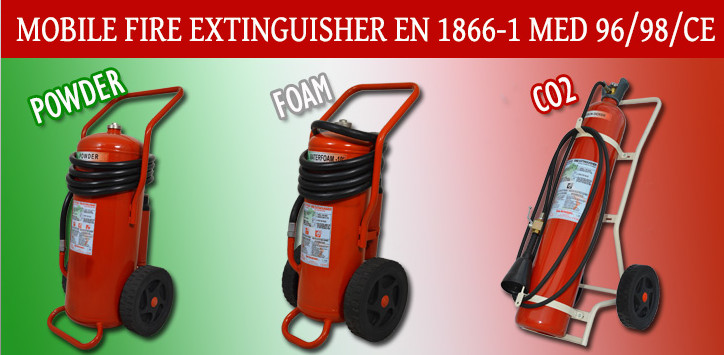Emme Antincendio Mobile Fire Extinguishers are according to UNI EN 1866-1 !

The standard specifies the rules for the planning, types test and inspection during the production, as the classification of the mobile fire extinguishers.
The standard concerns powder mobile fire extinguishers, water-based and carbone dioxide, that have more than 20 kg of weight.
This standard replaces the UNI 9492:1989.
“OMISSIS”
1 PURPOSE AND APPLICATION
This european standard specifies the rules for the planning, types test and inspection during the production, estimates and classifications for mobile fire extinguishers and way to use it.
The standard concerns powder, water-based and carbon dioxide mobile fire extinguishers, with more than 20 kg. of weight,.
This standard applies only to mobile fire extinguishers operated by a standing operator.
This standard doesn’t concern the extinguishing tests for fores of class C and F, but the extinguishing agent can be effective for these types of fires.
The extinction of class D fire is considered highly specialized and is not covered by this standard, but may be subject to country-specific.
2 NORMATIVE REFERENCE
The following standards are necessary for the application of this document:
EN 3-7 - Portable fire extinguishers - Parte 7: Characteristics, performance requirements and test
methods
EN ISO 3227 - Corrosion tests in artificial atmospheres - Salt spray tests ( ISO 9227:2006 )
3 TERMS AND DEFINITIONS
For the purpose of this European standard, it applies the terms and definitions below.
3.1 Pressure at the maximum operating temperature, PTS max (pressure measured experimentally):
Pressure measured for the fire extinguisher after a stabilization period of at least 24H TSmax operating temperature (> 60 ° C) and, for the fire extinguishers in the cartridge, the maximum pressure recorded for 0.5 s in a period of 3 minutes, excluding the first 5 s after the release of the propellant.
3.2 BODY:
Fire extinguisher shell lacking in accessories but it is completed of all the welded parts.
“OMISSIS”
3.4 FIRE EXTINGUISHER CHARGE:
Mass and volume of the extinguishing agent in the mobile fire extinguisher. “OMISSIS”
3.8 FIRE EXTINGUISHER:
Device that contains an extinguishing agent that can be expelled by internal pressure and aimed to the fire.
3.9 EXTINGUISHING AGENT
Material contained in the fire extinguisher that defines the extinction of the fire.
3.10 MOBILE FIRE EXTINGUISHER
Fire extinguisher designed to be carried and operated by hand, with a mass of more than 20 kg.
3.11 PROPELLANT GAS
Liquid or pressurized gas, that provides internal pressure used to expel extinguishing agent.
“OMISSIS”
3.13 RESIDUAL CHARGE
Mass or volume of the residual extinguishing agent after a continuous discharge, including all the propellant gas.
“OMISSIS”
3.14 WATER-BASED FIRE EXTINGUISHER
Fire extinguisher containing only water or water with an additive.
3.15 POWDER FIRE EXTINGUISHER
Fire extinguisher containing powder.
“OMISSIS”
5. FIRE EXTINGUISHER DESCRIPTION
5.1 TYPE OF EXTINGUISHING AGENT
A fire extinguisher is described according with the type of extinguishing agent it contains:
- Powder fire extinguisher;
- Water-based fire extinguisher;
- Carbon dioxide fire extinguisher.
5.2 FIRE EXTINGUISHER ELEMENTS
A mobile fire extinguisher consists of the following elements:
- Body extinguisher;
- Wheels;
- Grip device;
- Body accessories, fixed or screwed, which include:
- Cylinder for the propellant;
- Control device;
- Hose;
- Main closure;
- Actuating device.
“OMISSIS”
6.4 SEAL OF THE PROPELLANT
6.4.1 DETAILS
The fire extinguishers and the tanks of the propellant must be designed to allow the seal test at regular intervals.
6.4.2 TANKS OF THE PROPELLANT
The mass and the pressure of the gaseous propellant must be verified by defining the weight and checking pressure.
All the required information must be marked on the cylinder.
6.4.3 PERMANENT PRESSURE FIRE EXTINGUISHER
6.4.3.1 POWDER AND WATER-BASED FIRE EXTINGUISHER
It must be possible to control the pressure fire extinguishers charge by measuring the internal pressure.
This must be done through a connection that allows to control the internal pressure by an independent device.
This connection must be provided with a lock that hold the pressure and it must communicate directly with the content under pressure.
It must be fitted with a pressure marker.
6.4.3.2. CARBON DIOXIDE FIRE EXTINGUISHER
The state of the charge of carbon dioxide fire extinguishers is confirmed by weighing.
“OMISSIS”
6.6 WORKING POSITION
In the usual working position, the fire extinguishers with their nominal charge must stay stable when the hose, completely unrolled, is pulled with a force of 150N.
The direction of the force is applied in an adverse condition.
6.8 OPERATION DEVICES
6.8.1 DETAILS
With the exception of the safety devices to prevent the accidental activation of the operation device, the fire extinguisher must not contain components that have to be added or removed before the use.
“OMISSIS”
6.8.5 PRESSURE GAUGE
6.8.5.1 DETAILS
Powder and water based fire extinguishers must be equipped with a pressure gauge.
To verify the correct operation, the pressure gauge must be inspected by an independent apparatus that uses the application of pressure.
“OMISSIS”
6.10 PERIODIC CHECKS
It must be possible control periodically each fire extinguisher in accordance with national specifications.
“OMISSIS”
8. EXTINGUISHING CAPABILITY
8.1 EXTINGUISHING TEST WITH CLASS A FIRE
8.1.1 DETAILS
The fire test class A must conform to EN 3-7.
8.1.2 POWDER FIRE EXTINGUISHERS
The powder must have already been subjected to tests performed by an accredited laboratory of a portable fire extinguisher 9 kg, according to EN 3-7 on at least a class 34 A fire as specified in EN 3-7.
8.1.3 WATER - BASED FIRE EXTINGUISHER
The water-based extinguishing agent must already be positively subjected to tests performed by an accredited laboratory, on a portable fire extinguisher from 9L, according to EN 3-7 on at least a class 13A fire as specified in EN 3- 7.
8.2 EXTINGUISHING TEST WITH CLASS B FIRE
8.2.1 DETAILS
For powder fire extinguishers and water-based fire extinguishers, (if the classification for extinguishing capacity of class B is required) follow the classification of the class B fire test shown in Table 9.
For carbon dioxide fire extinguishers are to be used other extinguishing tests as specified in EN 3-7.


